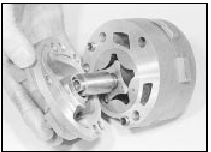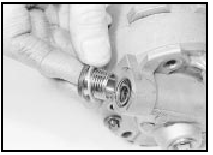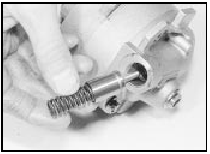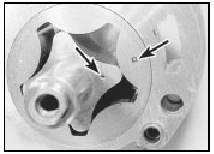Oil pump - dismantling, inspection and reassembly
Dismantling
1 The oil pump can be dismantled for
cleaning, but if any of the components are
worn, the pump must be renewed as an
assembly.
2 To dismantle the pump, proceed as follows.
3 Unscrew the two securing bolts, and remove the pump cover (see illustration).

27.3 Removing the oil pump cover
4 Lift the inner and outer rotors from the pump casing.
5 Unscrew the pressure relief valve plug from the pump cover, recover the washer, and withdraw the spring and plunger (see illustrations).

27.5a Unscrew the pressure relief valve plug and washer . . .

27.5b . . . and withdraw the spring and plunger
Inspection
6 Thoroughly clean all components in petrol or
paraffin, and wipe dry using a non-fluffy rag.
7 Examine the rotors and the pump casing for signs of excessive wear on the machined surfaces. If wear is evident, the complete pump assembly must be renewed, as spare parts are not available individually.
Reassembly
8 Commence reassembly by lubricating the
relief valve plunger. Fit the plunger and the
spring, and screw the plug into place,
ensuring that the washer is in place under the
plug.
9 Lubricate the rotors, and fit them to the pump casing with the punch marks facing the pump cover (see illustration).

27.9 The punch marks (arrowed) on the oil pump rotors must face the pump
cover
10 Refit the pump cover and tighten the securing bolts.
11 Prime the pump before refitting.
Oil pump drive chain and sprockets - examination and renovation
1 Examine all the teeth on the sprockets. If the teeth are “hooked” in appearance, renew the sprockets.
2 Examine the chain tensioner for wear, and renew it if necessary.
3 Examine the chain for wear. If it has been in operation for a considerable time, or if when held horizontally (rollers vertical) it takes on a deeply-bowed appearance, renew it.
See also:
Rear shock absorber - removal and refitting
Saloon and Hatchback models
1 With the weight of the vehicle resting on the
roadwheels, work under the vehicle to
unscrew and remove the shock absorber
lower mounting bolt and nut from the relevan ...
Distributor components (CVH models) - removal and refitting
1 The distributor fitted to the CVH engine is
unlike any conventional distributor, in that it
has no main body and no adjustments are
possible. The distributor is used purely to
distribute HT volt ...
Camshafts and cam followers - removal, inspection and refitting
Note: Once the timing chain has been
removed from the camshaft sprockets, do not
turn the crankshaft until the timing chain has
been correctly refitted - this is to prevent
contact between the val ...
